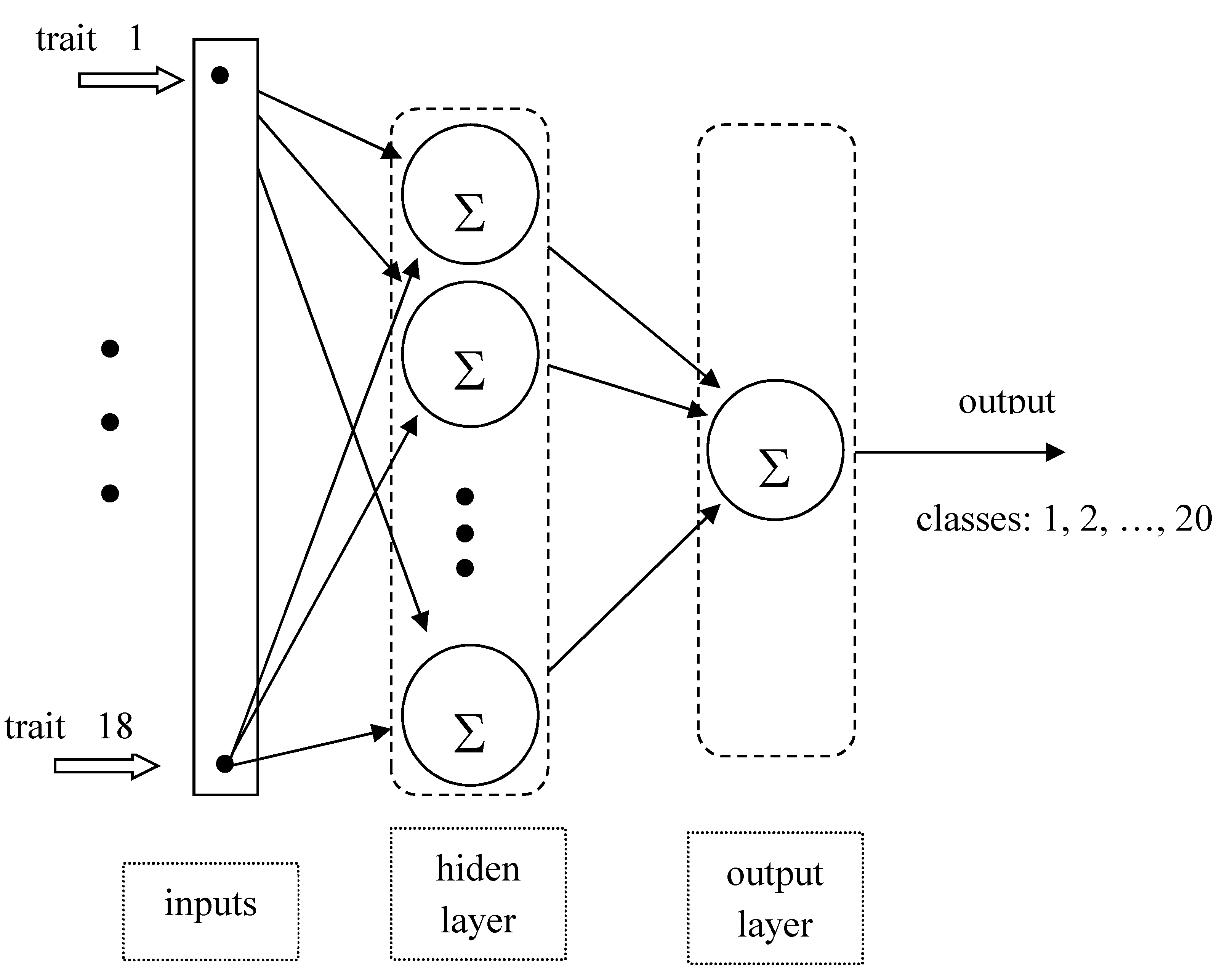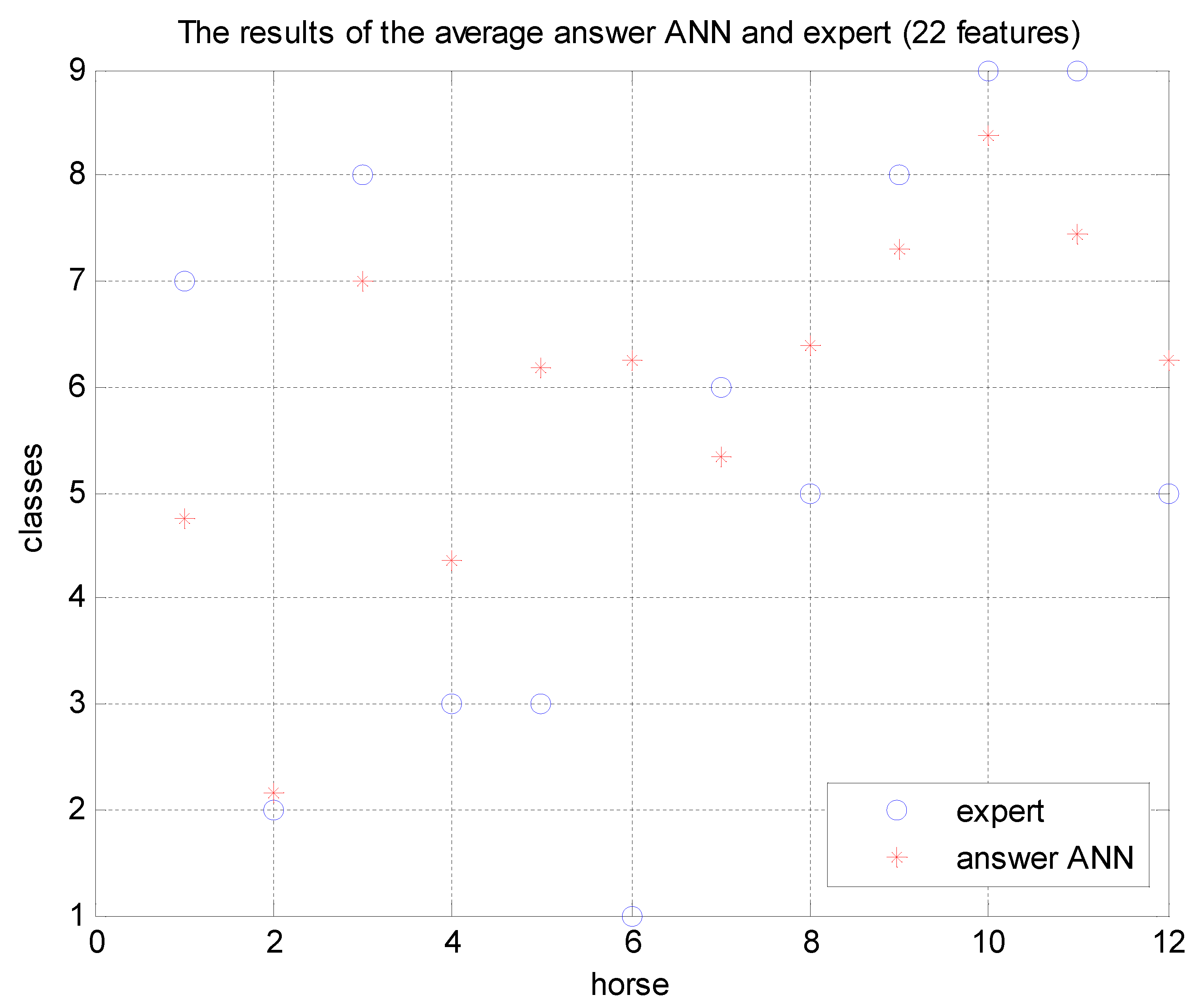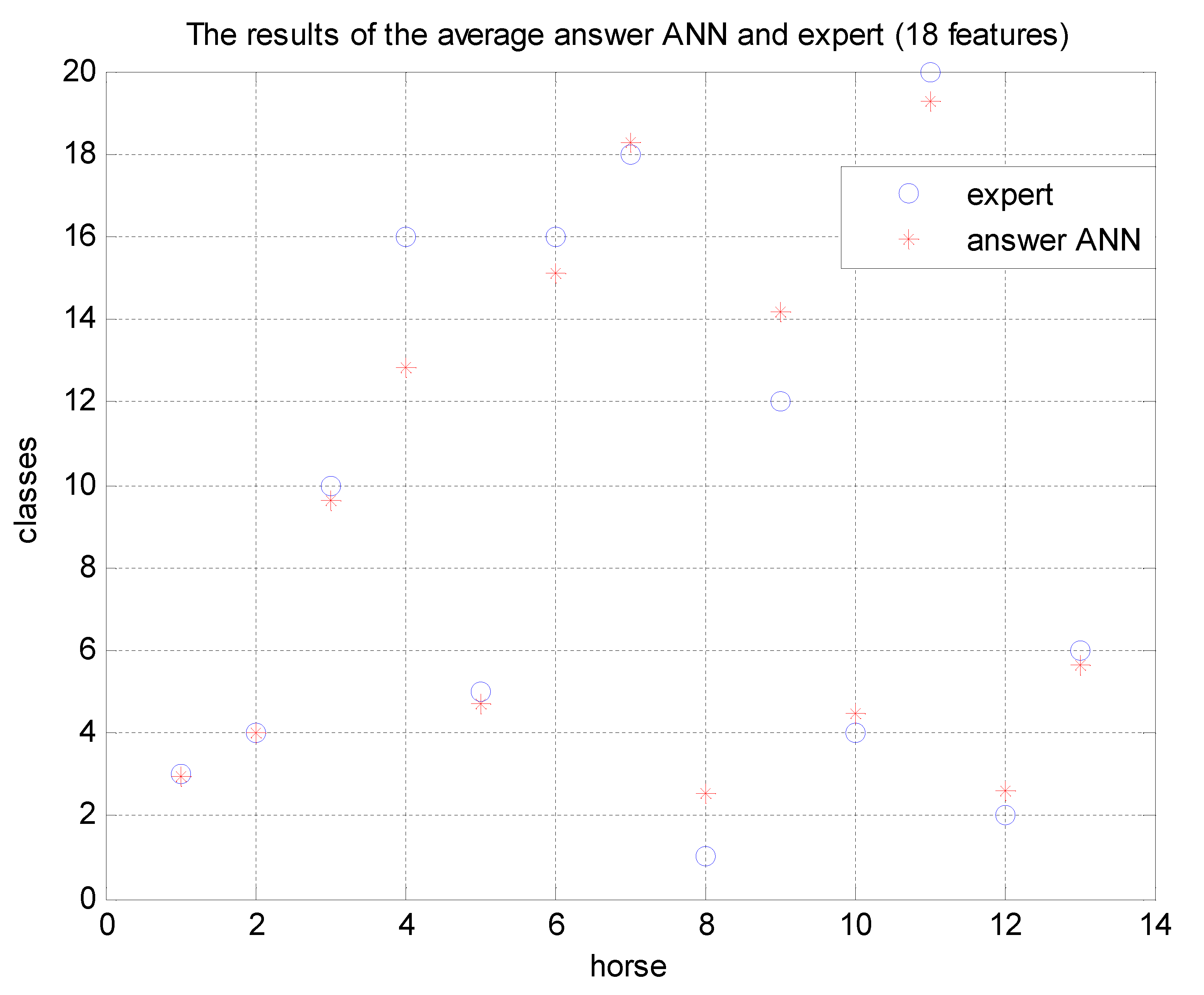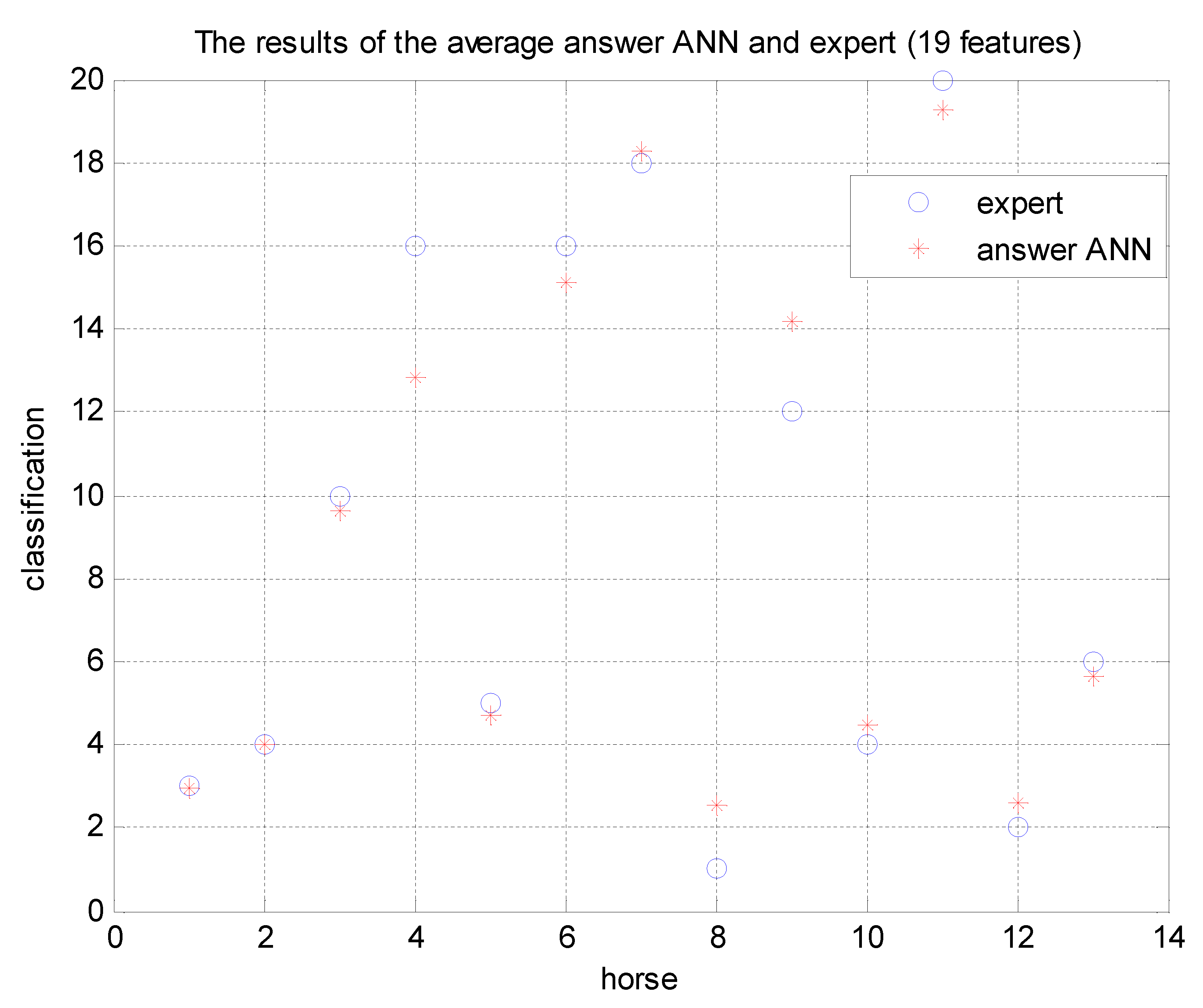Forecasting the Utility Value of Hucul Horses by Means of Artificial Intelligence
Abstract
1. Introduction
2. Materials and Methods
2.1. Research Methodology
- Model 1—with 21 explanatory variables that include sex, age, father, lineage, family, breeder, owner and the attributes being assessed during the championships.
- Model 2—with 18 explanatory variables similar to model 1 except for the breeder, forms of ownership and inbreeding coefficient.
- Model 3—with 19 explanatory variables similar to model 2 but with information about the number of participations of the individual within the study period being included.
2.2. Configuration of the Artificial Neural Network
3. Results
4. Discussion
5. Conclusions
Author Contributions
Funding
Conflicts of Interest
References
- Becker, T.; Enders, T.; Delgado, A. Dynamic neural networks as a tool for the online optimization of industrial fermentation. Bioproc. Biosyst. Eng. 2002, 24, 347–354. [Google Scholar] [CrossRef]
- Torrecilla, J.S.; Aragon, J.M.; Palancar, M. Optimization of an artificial neural network by selecting the training function. Application to olive oils mills waste. Ind. Eng. Chem. Res. 2008, 47, 7072–7080. [Google Scholar] [CrossRef]
- Schobesberger, H.; Peham, C. Computerized Detection of Supporting Forelimb Lameness in the Horse Using an Artificial Neural Network. Vet. J. 2002, 163, 77–84. [Google Scholar] [CrossRef]
- Gorgulu, O. Prediction of 305-day milk yield in Brown Swiss cattle using artificial neural networks. S. Afr. J. Sci. 2012, 42, 280–287. [Google Scholar] [CrossRef]
- Fraiwan, M.A.; Abutarbushb, S.M. Using Artificial Intelligence to Predict Survivability Likelihood and Need for Surgery in Horses Presented With Acute Abdomen (Colic). J. Equine Vet. Sci. 2020, 90, 102973. [Google Scholar] [CrossRef]
- Hyde, R.M.; Down, P.M.; Bradley, A.J.; Breen, J.E.; Hudson, C.; Leach, K.A.; Green, M.J. Automated prediction of mastitis infection patterns in dairy herds using machine learning. Sci. Rep. 2020, 10, 4289. [Google Scholar] [CrossRef]
- Shanhinfar, S.; Page, D.; Guenther, J.; Cabrera, V.; Fricke, P.; Weigel, K. Prediction of insemination outcomes in Holstein dairy cattle using alternative machine learning algorithms. J. Dairy Sci. 2014, 97, 731–742. [Google Scholar] [CrossRef]
- Saxena, P.; Parasher, Y. Application of Artificial Neural Network (ANN) for Animal Diet Formulation Modeling. Proc. Comput. Sci. 2019, 152, 261–266. [Google Scholar] [CrossRef]
- Nadimi, E.S.; Jørgensen, R.N.; Blanes-Vidal, V.; Christensen, S. Monitoring and classifying animal behavior using ZigBee-based mobile ad hoc wireless sensor networks and artificial neural networks. Comput. Electron. Agric. 2012, 82, 44–54. [Google Scholar] [CrossRef]
- Fernández, C.; Soria, E.; Martín, J.D.; Serrano, A.J. Neural networks for animal science applications: Two case studies. Expert. Syst. Appl. 2006, 31, 444–450. [Google Scholar] [CrossRef]
- Panchal, I.; Sawhney, I.K.; Sharma, A.K.; Dang, A.K. Classification of healthy and mastitis Murrah buffaloes by application of neural network models using yield and milk quality parameters. Comput. Electron. Agric. 2016, 127, 242–248. [Google Scholar] [CrossRef]
- Zaborski, D.; Grzesiak, W. Detection of difficult calvings in dairy cows using neural classifier. Arch. Tierz. 2011, 54, 477–489. [Google Scholar] [CrossRef]
- Eksteen, S.; Breetzke, G.D. Predicting the abundance of African horse sickness vectors in South Africa using GIS and artificial neural networks. S. Afr. J. Sci. 2011, 107, 20–28. [Google Scholar] [CrossRef]
- Ehret, A.; Hochstuhl, D.; Gianola, D.; Thaller, G. Application of neural networks with back-propagation to genome-enabled prediction of complex traits in Holstein-Friesian and German Fleckvieh cattle. Genet. Sel. Evol. 2015, 47, 22. [Google Scholar] [CrossRef] [PubMed]
- Kasperski, A.; Kasperska, R. A new approach to the automatic identification of organism evolution using neural networks. BioSystems 2016, 142–143, 32–42. [Google Scholar] [CrossRef]
- Castillo, E.; Guijarro-Berdiñas, B.; Fontenla-Romero, O.; Alonso-Betanzos, A. A Very Fast Learning Method for Neural Networks Based on Sensivity Analysis. J. Mach. Learn. Res. 2006, 7, 1159–1182. [Google Scholar]
- Purzyc, H. A general characteristic of Hucul horses. Acta Sci. Pol. Med. Vet. 2007, 6, 25–31. [Google Scholar]
- Topczewska, J.; Krupa, W. Impact of maintenance systems on the Hucul mares reproductive rates. Arch. Tierz. 2016, 56, 246–254. [Google Scholar] [CrossRef][Green Version]
- Fornal, A.; Radko, A.; Piestrzyńska-Kajtoch, A. Genetic polimorphism of Hucul horses population based on 17 microsatellite loci. Acta Biochim. Pol. 2013, 60, 761–765. [Google Scholar] [CrossRef]
- Topczewska, J.; Krupa, W. Effect of some factors on championship results and performance in Hucul horses. Ann. Anim. Sci. 2018, 18, 209–224. [Google Scholar] [CrossRef]
- Hucul Horse Breeding Program; PZHK-Polish Horse Breeders Association: Warsaw, Poland, 2014.
- Topczewska, J. A Set of Source Data of Hucul Horses. University of Rzeszów Database Repository, 2020. Available online: http://repozytorium.ur.edu.pl/handle/item/5698 (accessed on 27 September 2020).
- Hush, D.; Horne, B. Progress in supervised neural networks. IEEE Signal. Process. Mag. 1993, 10, 8–39. [Google Scholar] [CrossRef]
- Vapnik, V. The Nature of Statistical Learning Theory; (Information Science and Statistics); Springer: Berlin/Heidelberg, Germany, 2000; ISBN 978-0-387-98780-4. [Google Scholar]
- Madsen, K.; Nielsen, H.B.; Tingleff, O. Methods for Non-Linear Least Squares Problems, 2nd ed.; Technical University of Denmark: Lyngby, Denmark, 2004. [Google Scholar]
- Larochelle, H.; Bengio, Y.; Louradour, J.; Lamblin, P. Exploring Strategies for Training Deep Neural Networks. J. Mach. Learn. Res. 2009, 1, 1–40. [Google Scholar]
- Demuth, H.; Beale, M. Neural Networks Toolbox; For Use with MATLAB; MathWorks. Inc.: Natick, MA, USA, 2002. [Google Scholar]
- Duch, W.; Korbicz, J.; Rutkowski, L.; Tadeusiewicz, R. Neural Networks, Biocybernetics and Biomedical Engineering; 6 Academic Publishing House EXIT: Warsaw, Poland, 2000. (In Polish) [Google Scholar]




© 2020 by the authors. Licensee MDPI, Basel, Switzerland. This article is an open access article distributed under the terms and conditions of the Creative Commons Attribution (CC BY) license (http://creativecommons.org/licenses/by/4.0/).
Share and Cite
Topczewska, J.; Kwater, T. Forecasting the Utility Value of Hucul Horses by Means of Artificial Intelligence. Sustainability 2020, 12, 7989. https://doi.org/10.3390/su12197989
Topczewska J, Kwater T. Forecasting the Utility Value of Hucul Horses by Means of Artificial Intelligence. Sustainability. 2020; 12(19):7989. https://doi.org/10.3390/su12197989
Chicago/Turabian StyleTopczewska, Jadwiga, and Tadeusz Kwater. 2020. "Forecasting the Utility Value of Hucul Horses by Means of Artificial Intelligence" Sustainability 12, no. 19: 7989. https://doi.org/10.3390/su12197989
APA StyleTopczewska, J., & Kwater, T. (2020). Forecasting the Utility Value of Hucul Horses by Means of Artificial Intelligence. Sustainability, 12(19), 7989. https://doi.org/10.3390/su12197989




